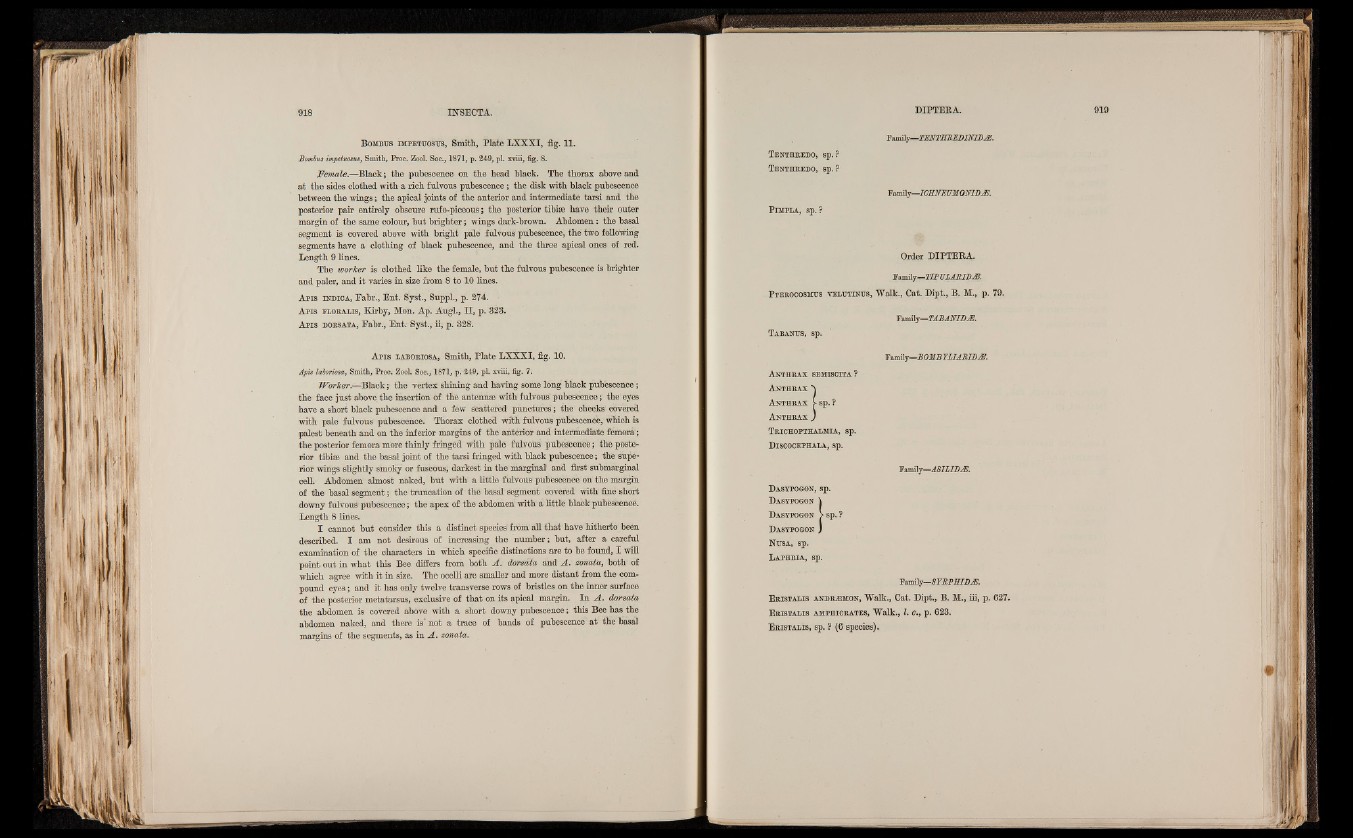
B om bu s impetttostjs, Smith, Plate LXXXI, f ig . 1 1 .
Bombus impetimus, Smith, Proc. Zool. Soc., 1871, p. 249, pi. xviii, fig. 8.
,Female.—Black ; the pubescence on the head black. The thorax above and
at the sides clothed with a rich fulvous pubescence ; the disk with black pubescence
between the wings ; the apical joints of the anterior and intermediate tarsi and the
posterior pair entirely obscure rufo-piceous ; the posterior tibiæ have their outer
margin of the same colour, but brighter ; wings dark-brown. Abdomen : the basal
segment is covered above with bright pale fulvous pubescence, the two following
segments have a clothing of black pubescence, and the three apical ones of red.
Length 9 lines.
The worker is clothed like the female, but the fulvous pubescence is brighter
and paler, and it varies in size from 8 to 10 lines.
A p i s in h ic a , Eabr., Ent. Syst., Suppl., p. 274.
A p i s f l o r a l is , Kirby, Mon. Ap. Augl., II, p. 3 2 3 .
A p i s d o r sa Ta, Eabr., Ent. Syst., ii, p. 328.
A p i s l a b o r io sa , Smith, Plate LXXXI, fig. 10.
Apis laboriosa, Smith, Proc. Zool. Soc., 1871, p. 249, pi. xviii, fig. 7.
Worker.—Black ; the vertex shining and having some long black pubescence ;
the face just above the insertion of the antennæ with fulvous pubescence ; the eyes
have a short black pubescence and a few scattered punctures ; the cheeks covered
with pale fulvous pubescence. Thorax clothed with fulvous pubescence, which is
palest beneath and on the inferior margins of the antériôr and intermediate fémorâ ;
the posterior femora more thinly fringed with pale fulvous pubescence ; the posterior
tibiæ and the basal joint of the tarsi fringed with black pubescence ; the superior
wings slightly smoky or fuscous, darkest in the marginal and first submarginal
cell. Abdomen almost naked, but with a little fulvous pubescence on the margin
of the basal segment; the truncation of thé basal segment covered with fine short
downy fulvous1 pubescence ; the apex of the abdomen with a little black pubëscence.
Length 8 lines.
I cannot but consider this a distinct species from all that have hitherto been
described. I am not desirous of increasing the number; but, after a careful
examination of the characters in which specific distinctions are to be found, I will
point out in what this Bee differs from both A . dorsata and A. zonata, both of
which agree with it in size. The ocelli are smaller and more distant from the compound
eyes ; it has only twelve transverse rows of bristles on the inner surface
of the posterior metatarsus, exclusive of that on its apical margin. In A. dorsata
the abdomen is covered above with a short downy pubescence ; this Bee has the
abdomen naked, and there is* not a trace of bands of pubescence at the basal
margins of the segments, as in A. zonata.
Family—TENTHBEDINIBAE.
T e n t h r e d o , s p . P
T e n t h r e d o , s p . P
Familj —ICHNBUMONIBAl.
PlMPLA, s p . P
Order DIPTERA.
Family—2TP TJLARIDM
P t e r o c o s m u s v e l u t i n u s , Walk., Cat. Dipt., B. M., p. 79.
Yxa&y—TABANIM.
T a b a n u s , s p .
Family—BOMBTLIABIBJS.
A n t h r a x s e m i s c i t a ?
A n t h r a x ^
A n t h r a x > s p . ?
A n t h r a x j
T r i c h o p t h a lm i a , s p .
D i s c o c e p h a l a , s p .
Family—ASILIDAS.
D a s y p o g o n , s p .
D a sy p o g o n |
D a s y p o g o n > s p . P
D a s y p o g o n )
N u s a , s p .
L a p h r i a , s p .
Family—S YBBEIDM.
E r i s t a l i s A N D R A 3M O N , Walk., Cat. Dipt., B. M., i i i , p . 627.
E r i s t a l i s a m p h i c r a t e s , Walk., I. c., p . 623.
E r i s t a l i s , s p . ? ( 6 s p e c i e s ) .
»